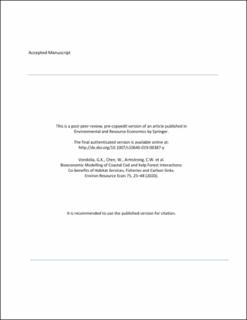| dc.contributor.author | Vondolia, Godwin K | |
| dc.contributor.author | Chen, Wenting | |
| dc.contributor.author | Armstrong, Claire W. | |
| dc.contributor.author | Norling, Magnus D | |
| dc.date.accessioned | 2020-08-27T13:46:09Z | |
| dc.date.available | 2020-08-27T13:46:09Z | |
| dc.date.created | 2020-01-17T14:25:32Z | |
| dc.date.issued | 2020 | |
| dc.identifier.citation | Environmental and Resource Economics. 2020, 75 (1), 25-48. | en_US |
| dc.identifier.issn | 0924-6460 | |
| dc.identifier.uri | https://hdl.handle.net/11250/2675415 | |
| dc.description | Embargo until 26 November 2020 | en_US |
| dc.description.abstract | Ecosystem-based fisheries management seeks to expand upon the traditional one-stock fisheries management measures by internalizing the effects of fishing on marine ecosystems, and accounting for biological interactions among marine resources. The fact that marine resources provide multiple, often competing benefits, makes the accomplishment of these ecosystem-based fisheries management objectives highly complex. In this paper, we develop a dynamic bioeconomic model to analyze the ecological and economic interactions between fisheries and renewable habitat where the habitat provides multiple ecosystem services. Specifically, a single resource manager seeks to maximize co-benefits of fishery-habitat interactions when the habitat is an exploitable marine resource, but also a dwelling place for commercial fish, enhancing the growth of the fish stock and providing regulating ecosystem services in the form of carbon sink for climate change mitigation. The optimal management rules for both fishery and habitat are derived and discussed. We also present an application of the model to analyze an integrated management of coastal cod and kelp forests in Norway, where regulations on commercial harvesting of kelp forests seek to protect fisheries. Both the theoretical model and the Norwegian application suggest substantial potential increases for both coastal cod and kelp forest stocks, with an attendant 8% increase in cod harvests, and about 1% reduction in kelp harvests. In addition, an optimal management regime that internalizes carbon sink co-benefits of kelp forests stores additional 300,000 tonnes of carbon. | en_US |
| dc.language.iso | eng | en_US |
| dc.publisher | Springer | en_US |
| dc.title | Bioeconomic Modelling of Coastal Cod and Kelp Forest Interactions: Co-benefits of Habitat Services, Fisheries and Carbon Sinks | en_US |
| dc.type | Peer reviewed | en_US |
| dc.type | Journal article | en_US |
| dc.description.version | acceptedVersion | en_US |
| dc.source.pagenumber | 25-48 | en_US |
| dc.source.volume | 75 | en_US |
| dc.source.journal | Environmental and Resource Economics | en_US |
| dc.source.issue | 1 | en_US |
| dc.identifier.doi | 10.1007/s10640-019-00387-y | |
| dc.identifier.cristin | 1775968 | |
| dc.relation.project | Framsenteret: ECOURCHIN | en_US |
| cristin.ispublished | true | |
| cristin.fulltext | postprint | |
| cristin.qualitycode | 1 | |
